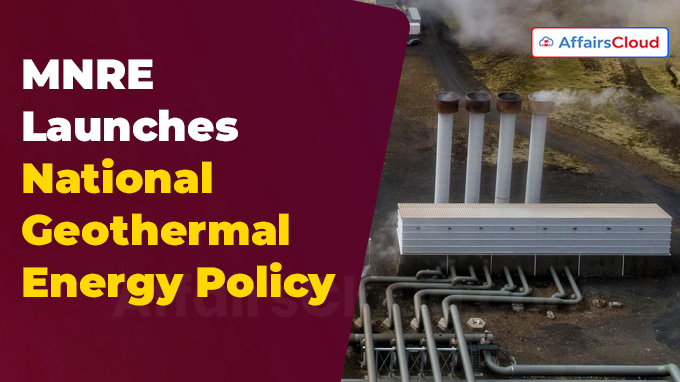 On September 17 2025, the Ministry of New and Renewable Energy (MNRE) officially notified the National Policy on Geothermal Energy (2025), aimed at accelerating clean energy transition in India as well as reaffirming the country’s commitment towards achieving the ambitious 2070 Net Zero target.
On September 17 2025, the Ministry of New and Renewable Energy (MNRE) officially notified the National Policy on Geothermal Energy (2025), aimed at accelerating clean energy transition in India as well as reaffirming the country’s commitment towards achieving the ambitious 2070 Net Zero target.
- This new policy provides a comprehensive framework which will help in promoting exploration, development, and utilization of geo-thermal energy in India.
Exam Hints:
- What? National Policy on Geothermal Energy (2025)
- Notified by: Ministry of New & Renewable Energy (MNRE)
- Purpose: To generate power through geothermal, a clean and reliable energy source
- Projects: 5 pilot/resource assessment projects sanctioned in Phase-I
- Leasing Rights: Exploration + 30-year lease allowed
- Applications: District heating, agriculture, aquaculture, and space cooling and heating via GSHPs
- India’s Net-Zero Target: 2070
- Total Geothermal Provinces: 10
About National Policy on Geothermal Energy 2025:
Objective: This newly policy aims to use India’s untapped geothermal energy potential through research, innovation, technology, ecosystem development, among others, for power generation and direct-use applications like: district heating agriculture, aquaculture, and space cooling and heating via Ground Source Heat Pumps (GSHPs).
Projects Sanctioned: For the initial phase, MNRE has sanctioned 5 projects which include pilot initiatives and resource assessment projects.
- These projects aimed to explore the viability and potential of geothermal energy in India.
Nodal Agency: MNRE will serve as the nodal agency for the implementation of geothermal energy-based projects in India.
Exploration & Leasing Rights: Under the policy, project developers can secure exploration permits and obtain long-term leases of up to 30 years.
Regulatory Facilitation: State governments have been advised to set up single-window clearance systems to ensure faster project approvals.
Key Features:
Research & Global Best Practices: The policy aims to promote research, inter-ministerial collaboration, and adoption of internationally-recognised best practices for geothermal energy development.
Integration with National Targets: It aims to integrate geothermal energy with India’s Net-Zero target and renewable energy objectives.
Applications: The new policy focuses on electricity generation, space heat/cooling, agriculture, tourism, and desalination.
Technological Innovation: The policy will promote Research & Development (R&D) of advanced systems like: hybrid geothermal-solar plants, retrofitting abandoned oil wells, and Enhanced/Advanced Geothermal Systems (EGS/AGS).
Local Innovation and Partnerships: The newly launched policy emphasis on local innovation, joint ventures, and repurposing existing oil or gas infrastructure.
Collaborations: It aims to foster collaborations with international geothermal bodies and pioneering countries as well as partnerships with state governments, oil and gas companies, and research institutions.
Ecosystem Development: The policy aims to build a strong public-private ecosystem for the long-term development of the geothermal sector.
Capacity Building: The policy will promote knowledge sharing and Human Resource Development (HRD) in geothermal sector.
Geothermal Provinces and Energy Sites in India:
Geothermal Provinces: Since 1973, the Geological Survey of India (GSI)has identified 381 hot springs spread across 10 geothermal provinces in India.
- These include the Himalayan Province covering Jammu & Kashmir(J&K), Himachal Pradesh(HP), and Uttarakhand; the Cambay Graben in Gujarat; the Aravalli Province in Rajasthan; the Mahanadi Basin spread across Odisha and Chhattisgarh; and the Godavari Basin in Andhra Pradesh and Telangana. Other important provinces are the Son–Narmada–Tapti (SONATA) Lineament Belt in Madhya Pradesh(MP) and Maharashtra; the West Coast Province covering Maharashtra, Goa, and Kerala; the Surajkund–Jharkhand Province in Jharkhand; the Sohana Province in Haryana; and the Andaman–Nicobar Islands Province in the Andaman & Nicobar Islands.
Geothermal Energy Sites: At present, GSI has identified geothermal energy sites across 16 Indian states which include Sidhu in J&K; Puga Valley, Panamik, and Chumathang in Ladakh; Manikaran in HP; Tapovan in Uttarakhand; Tsachu (Tawang) and Takshing in Arunachal Pradesh (AR); Sohana in Haryana; Surajkund in Jharkhand; Bakreshwar in West Bengal (WB); Tattapani in Chhattisgarh; Atri in Odisha; Unai and Tuwa in Gujarat; and Rajgir in Bihar.
About Ministry of New & Renewable Energy (MNRE):
Union Minister- Pralhad Joshi (Constituency- Dharward, Karnataka)
Minister of State (MoS)- Shripad Yesso Naik (Rajya Sabha- North Goa, Goa)



